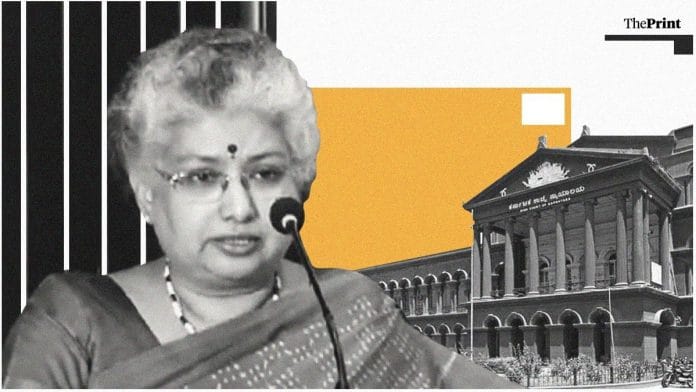New Delhi: The Supreme Court collegium led by former Chief Justice of India S.A. Bobde failed to arrive at a consensus on recommending Karnataka High Court judge, Justice B.V. Nagarathna to the top court before Bobde’s retirement, ThePrint has learnt. Justice Nagarathna’s elevation to the SC is significant because if done now, she could go on to become India’s first woman CJI.
However, according to sources, two members of the high-powered panel felt that she should not be allowed to supersede the elevation of her senior — the Chief Justice of Karnataka HC, Justice A.S. Oka.
Four collegium meetings were convened during former CJI Bobde’s tenure to discuss possible names for elevation. The panel comprised present CJI, Justice N.V. Ramana, and Justices R.F. Nariman, U.U. Lalit and A.M. Khanwilkar.
Justice Nagarathna was one of the prominent names in the deliberations since she is the only woman judge from 82 HC judges who could, on elevation, succeed Justice Surya Kant on 9 February 2027 as India’s CJI. She will hold the post till 29 October 2027.
Sources familiar with the matter told ThePrint that two members of the collegium did not favour the supersession of Justice Oka, who is first on the all-India seniority list of Chief Justices. He was appointed as a judge to the Bombay High Court in August 2003 and became Karnataka HC Chief Justice in May 2019.
But Bobde did not accept the suggestion and maintained that it was important to elevate Nagarathna since she was a potential candidate for the CJI’s post in future.
Bobde also noted that Justice Oka’s elevation should be done after the former’s retirement on 23 April.
“In his opinion Bombay HC had adequate representation in SC, because four sitting judges, including himself, were from that court,” a source said.
As all the four collegium meetings remained inconclusive due to the impasse, it delayed the chances of Nagarathna’s elevation.
Also read: Only 2 woman judges in SC and 82 of 1,079 judges in HCs — judiciary has a gender problem
Oppositions to Justice Nagarathna’s elevation
While Oka is the senior-most judge in all-India rankings, Nagarathna’s rank is 33. However, she is presently the senior-most judge in Karnataka HC after Oka, and at present, there are only two SC judges from her high court.
One of the oppositions to her candidature in the past was that her elevation will lead to the supersession of 32 senior judges. Of them, 19 are chief justices and some senior-most judges are already in consideration for the top court.
However, there have been precedents where judges, lower than the Chief Justice’s rank, were elevated to the Supreme Court. Recent examples include the elevation of Justice S.A. Nazeer from the Karnataka High Court and Justice Sanjiv Khanna from Delhi HC. Both served in their respective high courts for 14 years before being appointed to the apex court.
“There are no written rules for appointment of judges to SC. Seniority and regional representation are usually the criteria for such appointments,” the source, quoted above, told ThePrint.
Another objection to Nagarathna’s name was that there were already three judges from the Karnataka HC in the SC. However, one of them, Justice Mohan Shantanagoudar, passed away recently and now there are only two judges left from the high court.
However, Justice Nagarathna’s chance to have an eight-month-long term as CJI can diminish if Justice Vikram Nath — the present Chief Justice of Gujarat HC and fifth in the seniority list — is appointed to the SC before her.
If this happens, she will hold the CJI office for just over a month — from 23 September 2027 to 29 October 2027. An SC judge can hold CJI’s office only till the age of 65.
Also read: India’s district court judges don’t show in-group bias against women, Muslims: Study
Only 1 woman judge in SC
According to sources, the new collegium led by CJI Ramana will reconsider Nagarathna’s name again, particularly since two of its members have publicly said that its time India had more women judges in SC and a woman CJI.
The collegium now comprises Justices Nariman, Lalit, Khanwilkar and D.Y. Chandrachud. Both Justices Khanwilkar and Chandrachud are from Bombay HC.
With two women judges — Justices R.A. Banumathi and Indu Malhotra — retiring within eight months of each other, the top court is left with only one woman judge, Justice Indira Banerjee, who is also set to retire next year.
At present, there are only 28 judges in the SC out of the sanctioned strength of 34.
In its 71 years, the top court has had only eight women judges. The first woman judge — Justice Fathima Beevi — was elevated to the court, 39 years after the SC was established.
(Edited by Rachel John)
Also read: Sexism in Indian judiciary runs so deep it’s unlikely we will get our first woman CJI






